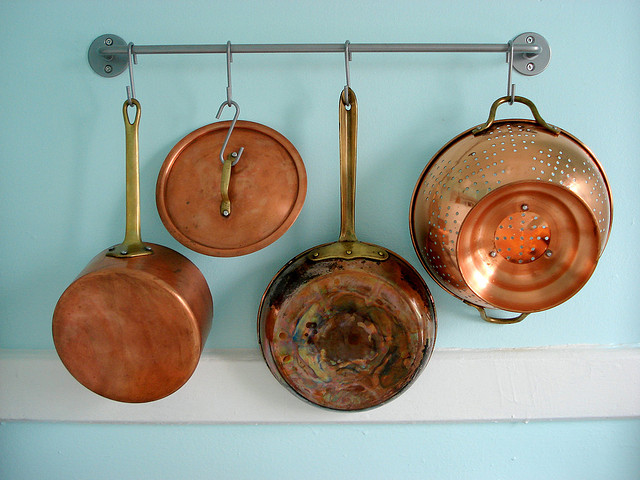
Pots and pans by Jocelyn Durston
- Dutch oven /Braising pan/Casserole
- Frying pan/Skillet/Omelette pan
- Saucepans
- Sauté pan
- Stockpot
- Bain-Marie/Double boiler
- Couscoussier
- Espresso maker
- Fish kettle/Fish steamer
- Griddle pan
- Grill pan
- Spaghetti pan/Pasta pan
How to Buy:
Choosing and buying the right pots and pans will make it easier for you to produce great food.
4 factors to consider:
Material: The main determinant for buying the right equipment is the material (more on this below), its weight and versatility (safe for the oven, stove top (hob) and grill/broiler). Generally you want rapid and even heat distribution (to avoid parts of the pan burning the food) and materials that are easy to clean and maintain.
Edges: Rolled edges make it easier to pour.
Handles: Handles that are long and stay cool are preferable, except if you are looking for a large pan which also needs to fit in the oven. Look for handles that are strong and connected firmly to the pan. They should fit well in your hand and be comfortable. A hole at the end of the handle is helpful if you’re going to hang the pan or if you want to poach something or put in a bag of herbs and tie it to the pot.
Lids: Lids should give a tight seal so that steam doesn’t escape or drip down the sides. Lid handles should stay cool.
Material Options
Summary
The best material is multi-layered, combining different metals each of which has particular advantages. These pans may be among the most expensive options, but well-made pots can last forever. I like to use the most common multi-layered combination, stainless steel with an inner layer of copper, copper and silver alloy, or aluminium. Of these, aluminium is by far the most common and the most cost-effective. All-Clad has a few options: the Copper Core collection, or the multi-layered collection made from stainless steel and aluminium. Scanpan also has aluminium, stainless or titanium pans with a lifetime non-stick ceramic surface which is chemical free. I love my Scanpan non-stick pans but I feel they are slightly heavier.
TYPES OF POTS AND PANS
ESSENTIAL PANS
Dutch oven /Braising pan/Casserole (Casseruòla)
Best for: Braising and stewing.
How to buy: This is a shallow, wide, usually straight-sided pan with a heavy bottom and an oven-proof lid. Casseroles come in all different sizes but ideally are made of a heavy material that slowly conducts heat but retains the heat and moisture for as long as possible. They can be oval or round; the oval shape makes more efficient use of oven space, while round ones can accommodate larger pieces of meat and larger quantities of food. The contents should just fit inside the pan so that as little liquid as possible is used to braise the meat or vegetables. The lid should be tight-fitting so that steam does not escape and condensation falls back into the pot. The handles should be firmly attached and easy to grab (particularly as the pot is heavy) but fit easily into the oven. These pots come in copper, stainless steel, cast iron, enamelled cast iron, glass, and earthenware.
I have two. One is a heavy-bottomed copper pan lined with tin, which is better for searing first and baking afterwards and which I also use for soups. My favourite is the Le Creuset enamelled cast iron Dutch oven that I use for braising. Glass or earthenware casseroles are also good but cannot be used on the stove top (hob).
Why buy one? Most other metal pots are made with material that conducts heat faster so it is difficult to maintain a consistently low temperature in order to braise or stew food properly and not scorch the food. You can use an earthenware pot instead but should cover with a layer of aluminium foil before adding the lid to ensure the steam doesn’t escape. If you use an earthenware pot but if you want to sear the food first you will need to do that in another pan and then add it to the earthenware pot. Metal braising pots have the advantage of not being temperature sensitive so can go from hot to cold and can brown food first on the stove top (hob) top.
How to use it: For braising, meats may or may not be browned first and then are slowly cooked on low heat with little liquid covering about one third of the meat and a tightly fitting lid. For stewing, the method is similar but the meat is cut up into small pieces and requires more liquid.
Frying pan/Skillet/Omelette pan (Padella)
Omelette pan
Frying pan
Non-stick frying pan
Cast iron skillet
Best for: This pan is used to fry, sear, or brown foods or reduce sauces. Pan frying uses hot fat to sear the food’s surface, making the outside crisp and keeping the inside juicy. Pan-frying is great for potatoes, grilled sandwiches, browning meat, eggs, omelettes, veal cutlets, etc.
How to buy: A frying pan has low flared sides with a long handle and no lid. Look for a large cooking surface circumference (20-30cm/8-12 inches) so it can hold food in one layer without touching and maximise the surface for cooking. I have three: one 20cm non-stick titanium Scanpan for omelettes and eggs, a 30cm non-stick titanium Scanpan for frying, and a 30cm cast iron for frying (particularly for food I don’t need to turn by flipping the pan). They should have a long handle – preferably one that does not get hot – and should be firmly attached to the pan so you can flip foods if needed. The handle should feel comfortable in your hands. Look for pans which have a good distribution of weight between the pan and the handle. Buy one that is not so thin the food scorches or so thick so that it is not responsive to changes in temperature. Non-stick frying pans are good because the food doesn’t stick and you can cook with less fat. I prefer the ceramic non-stick coating as it is more durable. Frying pans come in stainless steel, anodized aluminium, cast iron, titanium, and multi-layer stainless steel. I would buy any of these except stainless steel that is not multi-layered. Cast iron frying pans are perfect for frying meat or anything you want to add flavour to but do not need to flip because cast iron is quite heavy; cast iron also reacts with acid. They improve with age and use, and last forever.
Why buy one? For pan-frying, a sauté pan will not let liquids evaporate quickly enough for the food to brown evenly. A wok’s surface is not ideal for frying large pieces of food which need to brown evenly.
How to use: Frying uses more fat than sautéing and the food is cooked faster at high temperatures and typically turned to brown on all sides. In frying, the food is cooked more by the fat than by contact with the pan.
Saucepans (Casseruola/Saucier)
Saucier
Best for: Sauces, simmering, and poaching.
How to buy: Saucepans have tall, straight or slightly flared sides, a long handle, and a lid. There are also saucepans with a rounded bottom (saucier) which is convenient for custards, poaching, braising etc. where you need to ensure that no food sticks in the corners of the pan. These pots also enable you to use as little liquid as possible. Look for one which is light, with a larger diameter and a lip. The handle should fit comfortably in your hand and should not get hot. Choose one made from multi-layered metals, titanium, anodised aluminium, or copper. A non-stick surface is not necessary. It is a good idea to have 2 or 3 of these in different sizes, but get at least one 4.5-litre pan. I have 3 saucepans (1.4 litre, 2.5 litre, and 4.5 litre), and a 4.5 litre saucier.
Why buy one? Saucepans are used for making sauces when you don’t want to brown the food, don’t want the liquid to evaporate too quickly, and when you want the ingredients to be covered with as little liquid as possible. In a wok, sauté pan, frying pan, or large pot the surface area is too large so the liquid will evaporate too quickly – and if you fill the vessel with liquid to cover the food, there will be too much liquid and it will dilute the flavour.
How to use it: For making sauces, liquids can be cooked together or food may be browned first before the liquids are added. For poaching, liquids are usually infused with aromatics before the temperature is reduced and the food is placed in them to be gently poached.
Sauté pan (Sautéuse/Sautoir/Casseruòla bassa)
Best for: Sautéing, simmering, blanching, and shallow poaching.
How to buy: These come in copper, cast iron, aluminium, stainless steel, titanium, enamelled cast iron, and multi-layered materials. They should have a large circumference so they can hold food in one layer and maximise the surface for cooking. I typically use a 26cm sauté pan. Buy one that is not too thin (the food may scorch) or so thick so that it is unresponsive to changes in temperature. The low, straight-edged or slightly rounded sides let steam evaporate more quickly so the food browns, cooks evenly, and does not jump out when the pan is flicked. You want a long, sturdy handle which doesn’t get hot and is well connected to the pan. Sometimes they come with two loop handles and this is better if you have a lot of dishes which start on the stove top (hob) and finish in the oven. Sauté pans come with a lid.
Why buy one? You can use a wok or a frying pan, which will brown the food easily but may dry it out. Sautéing involves more moisture than frying. If you use a wok it may have the same scorching effect as the frying pan, particularly when cooking something for a relatively long time.
How to use: To sauté, use a small amount of fat to brown the food and cook over medium to high heat while moving the food around. One technique is to hold the pan by the handle and using a sharp movement with the arm to flip the food up in the pan. The food is cooked more by contact with the pan than by the oil or liquid.
Stockpot (Pentola)
Best for: Making stock, broth, soup, and preserves. Deep-frying, steaming, preserving, boiling pasta, and simmering. It is also handy for steaming large items of food.
How to buy: The stock pot should be taller than it is wide with straight sides, a lid, and two loop handles. Look for a wide one so you can move the food around in the pot and clean it more easily. A thick bottom is best, particularly if you will be sautéing or frying in the pan first. Look for firmly attached handles which extend sufficiently far from the pot that you can comfortably pick it up when it is full (and therefore very heavy and hot). A capacity of 13-15 litres should be sufficient for most purposes.
Why buy one? If you want to make soup or broth or cook items in bulk then this pot is indispensable. Since the pot is taller than it is wide, the liquid does not evaporate as quickly. For steaming, as long as the item is small enough to fit into a bamboo steamer, this is fine. For large items you will need a stockpot with a steamer inserted.
How to use it: For stock, add meat, bones, vegetables and aromatics. Cover with cold water. Bring to a boil and reduce to a simmer. To steam, add water to the bottom of the pot so it doesn’t touch the bottom of the steamer; bring to the boil. Add the food you’re steaming and tightly fit the lid and heat. To deep-fry food, use shallower pot so you can easily scoop the food out and don’t need to use too much fat. Add enough fat to submerge the food completely. Heat the fat to the desired temperature (you can use a deep-frying thermometer) and add the food so that it can fry in a single layer.
SPECIALITY PANS
Bain-Marie/Double boiler (Bagnomaría)
Best for: The bain-marie enables you to cook ingredients gently without bringing them into direct contact with your heat source. The food is cooked over – not in – boiling water. The simplest version is a wide bowl placed over a pan of boiling water so the steam can’t escape. Bain-maries are also manufactured by saucepan producers. Melting chocolate or cheese, making custard or zabaglione, whipping eggs with sugar, etc. It is excellent for cooking sauces containing egg where the temperature needs to remain below boiling, or for reheating sauces.
How to buy: The bain-marie has two straight-sided pans, one of which nests inside the other. It comes with a lid and a long handle. Look for handles which stay cool and fit comfortably in your hand. A rounded bowl for the top part of the pot is better to ensure that all the food gets evenly mixed. Look for pots that don’t have crevices which are difficult to clean. The pots can be made from copper, stainless steel, multi-layered, or aluminium. The top chamber can also be made out of porcelain.
Why buy one? If you are doing a lot of sauce or dessert making, it’s worth investing in a bain-marie as it offers a more stable, easier to hold alternative to the bowl over water.
How to use it: Pour water into the bottom pan (the depth will vary according to your recipe or pan) and place on the stove top (hob) over medium heat. When the water boils, place your food in the top portion of the pan as directed by the recipe and place on top of the bottom part of the bain-marie.
Couscoussier (Pentola per couscous)
Best for: Couscous.
How to buy: A couscousier is a pot with a steamer compartment on top and a lid. The couscous goes in the top of the pot. The food cooks in the bottom and produces steam which rises to the top, cooking and flavouring the couscous above. They are typically made of stainless steel or aluminium.
Why buy one? I don’t eat a lot of couscous, so I don’t really need one. You can substitute by lining a footed metal colander or wire basket with cheesecloth and placing it inside a covered stock pot with water to steam. If you use a wire basket instead of a colander you will need a steamer insert as well to keep it out of the water. Alternatively you can rest the colander on top of a pot with the stew and seal it with aluminium foil.
How to use it: Prepare the stew on the bottom of the couscousier, fill the top compartment with couscous, cover with the lid, and cook.
Espresso maker (Caffettièra Napoletana or Caffettièra espresso/Moka/Macchinetta)
Caffettièra Napoletana
Caffettièra espresso/Moka/Macchinetta
Best for: Making coffee
How to buy: These come in various metals, especially stainless steel, tin or aluminium, and sometimes in terracotta. They are taller than they are wide and can be cylindrical or conical. The base holds the water which, when heated, pushes steam up through the middle chamber holding the coffee and filter, to the top chamber which holds the finished coffee. There are two types of Italian stove top (hob) top coffee makers:
Caffettièra Napoletana: The Napoletana has two chambers, one on top and one on bottom, separated by a filter which holds the coffee grinds.
Caffettièra espresso/Moka/Macchinetta: The Moka has two chambers as well but the bottom chamber is much smaller than the top chamber. The two chambers are also separated by a filter filled with coffee.
Why buy one? It is easier to use and clean than an espresso machine and makes better coffee than drip coffee or coffee made in a coffee press. Espresso from a Moka can sometimes be better than one made from an espresso machine. Clean only with water.
How to use:
Caffettièra Napoletana: Unscrew the top and remove the filter. Water is poured into the bottom chamber up to the middle of the inner valve and the filter is placed on top and coffee is spooned into the filter to form a mound. Do not press down the coffee before screwing on the top. Bring the water to a boil over a low flame. The Napoletana is then removed from the heat and turned over to pass the water through the coffee grinds. People who like strong coffee might repeat this process a few times.
Caffettièra espresso/Moka/Macchinetta: Unscrew the top and remove the filter. Water (ideally, soft or filtered) is poured in the bottom chamber up to the middle of the inner valve; the filter is placed on top and the coffee is spooned into the filter to form a mound. Do not press down the coffee before screwing on the top. Bring the water to a boil over a low flame until the pressure forces the water up through the coffee grinds into the top chamber. When this process begins and the water can be heard bubbling, the machine is removed from the stove top.
Fish kettle/Fish steamer (Pescièra/Pesciaiòla)
Best for: Poaching or steaming fish
How to buy: Look for one which is long, deep, and narrow with straight sides. It should have a lid, 2 loop handles, and a wire rack for holding the fish. Buy one long enough to fit the types of fish you plan to cook. Some have two racks, one which sits lower in the pan for poaching and one which sits higher for steaming. The pan can be made from anodised aluminium, stainless steel, or copper.
Why buy one? If you want to poach a large whole fish then this pot is essential: having the same shape as the fish, it minimises the liquid required (which helps preserve flavour) and allows you to present a whole fish at the table. The rack makes it easy to remove the fish from the pan, keeping it whole and presentable.
How to use it: To poach the fish, create your aromatic poaching liquid, cover with the lid, and bring to the desired temperature. Place the fish on the low rack and lower it in. To steam the fish, add water to the bottom of the pan but do not let it touch the rack. Add the tall rack with the fish, cover with the lid and heat.
Griddle pan (Testo/Ferro)
Best for: Flatbreads such as testaroli, tigella, and crescentina.
How to buy: Look for a griddle pan which is light weight and retains heat well. Griddles can be round, 10-60cm in diameter, and have a single long handle, or rectangular, 25-45cm in size, and have heat-resistant loop-shaped handles. Both designs usually have a spout to pour off excess fat. Non-stick finishes are helpful. The round ones come in cast iron, ceramic cast aluminium, anodized aluminium, terracotta, and stoneware, whereas the rectangular ones are usually only made of metal. I would probably buy a rectangular anodized aluminium or cast iron. I currently use two cast-iron crèpe pans I have at home which work well.
Why buy one? It’s not entirely necessary if you have a large frying pan which heats evenly. It is easier to turn food on a griddle as there are no sides.
How to use it: Heat the pan and then griddle the bread as required in the recipe.
Grill pan (Bistecchiera/Griglia)
Best for: Indoor grilling of meat, fish, and vegetables.
How to buy: Look for a heavy-bottomed pan with a grooved bottom (with tall ridges about ½ cm high) and low flared sides. These pans come in a variety of round sizes with a long handle, or in a rectangular shape usually 20cm up to 50cm in length with fold-down loop handles. For the round pans, since the pan is heavy you will want to ensure that the handle is firmly connected, stays cool, and fits easily in your hand. Look for a pan with one or two spouted sides enabling you to easily pour off liquid and fat; you do not want these to accumulate or the food will not grill properly. For the same reason, look for a pan with the tallest ridges possible. Grill pans come in stainless steel, cast iron, and non-stick aluminium. You can now buy cast iron pans which are pre-seasoned. I prefer to use cast iron or enamelled cast iron for this pan as they retain heat well.
Why buy one? I love these pans. They add the most flavour to your food and are essential if you don’t have access to (or can’t bother with the fuss of) a barbecue. They are also a low-fat way to cook.
How to use: Heat the pan until hot, add the food to the pan until cooked on one side; turn and cook on the other side.
Spaghetti pan/Pasta pan (Pentola per pasta)
Best for: Boiling pasta
How to buy: A pasta pot is taller than it is wide. Typically made of stainless steel or aluminium, it has a perforated inner basket and a lid. Sometimes you can buy pans which have a shallow steamer insert as well.
Why buy one? Pasta pans tend to be expensive and are not necessary unless you make pasta often in which case their ease of use will be worth the price. Otherwise you can just use a stock pot. One benefit of having a pentola per pasta is that (a) you drain the pasta faster so that you can ensure it is perfectly cooked. Another is that it makes it easier to cook pasta in batches. I do batch one for my kids early in the evening and then keep the water going for when my husband comes home later so I don’t have to re-boil a pot of water or fiddle around with a slotted spoon trying find bits of old pasta lurking at the bottom. Also, if you need to add pasta water to a dish to loosen the sauce, you have as much as you need. Nothing is worse than draining the pasta and then realising you forgot to save some pasta water to loosen the sauce with. And note, finally, that the bottom part of the pentola can be used as a stockpot.
How to use it: Fill the pot with water and bring the water to a boil. Add salt and the pasta and cook for the time required. Lift the perforated insert and shake to loosen any water and the pasta is ready to serve. To use the water again, simply add more pasta.


















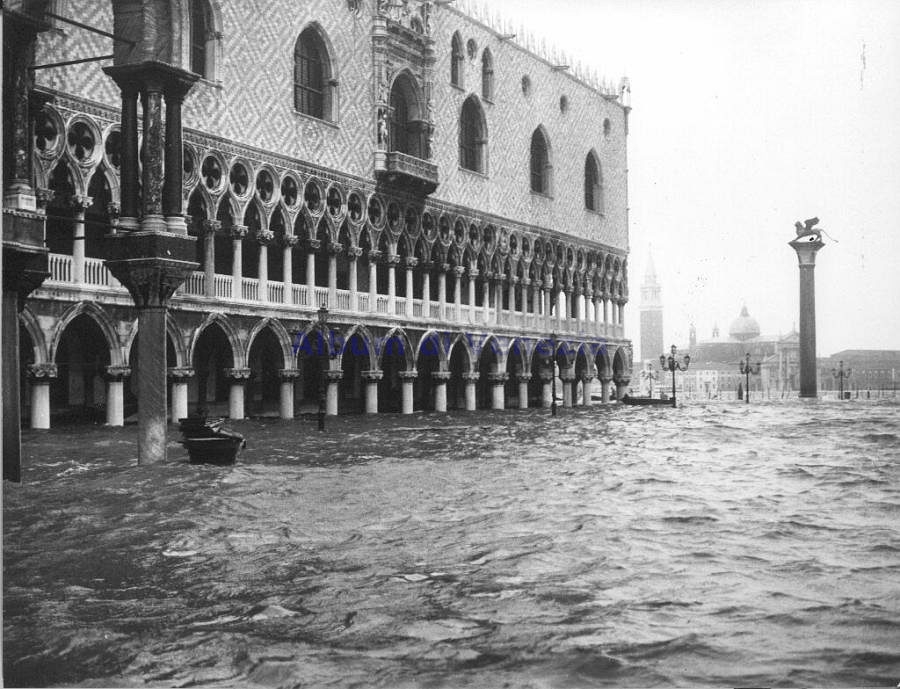
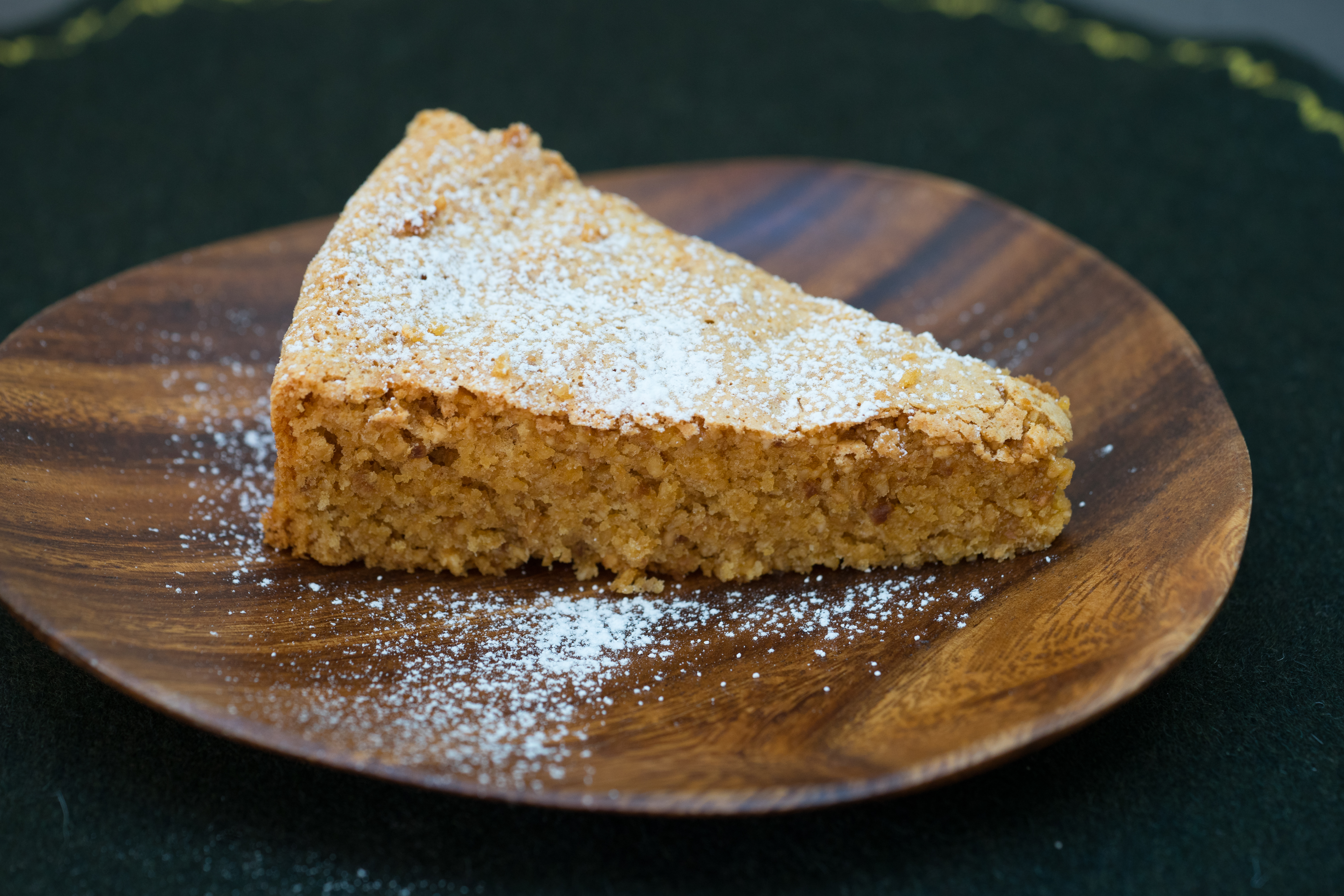
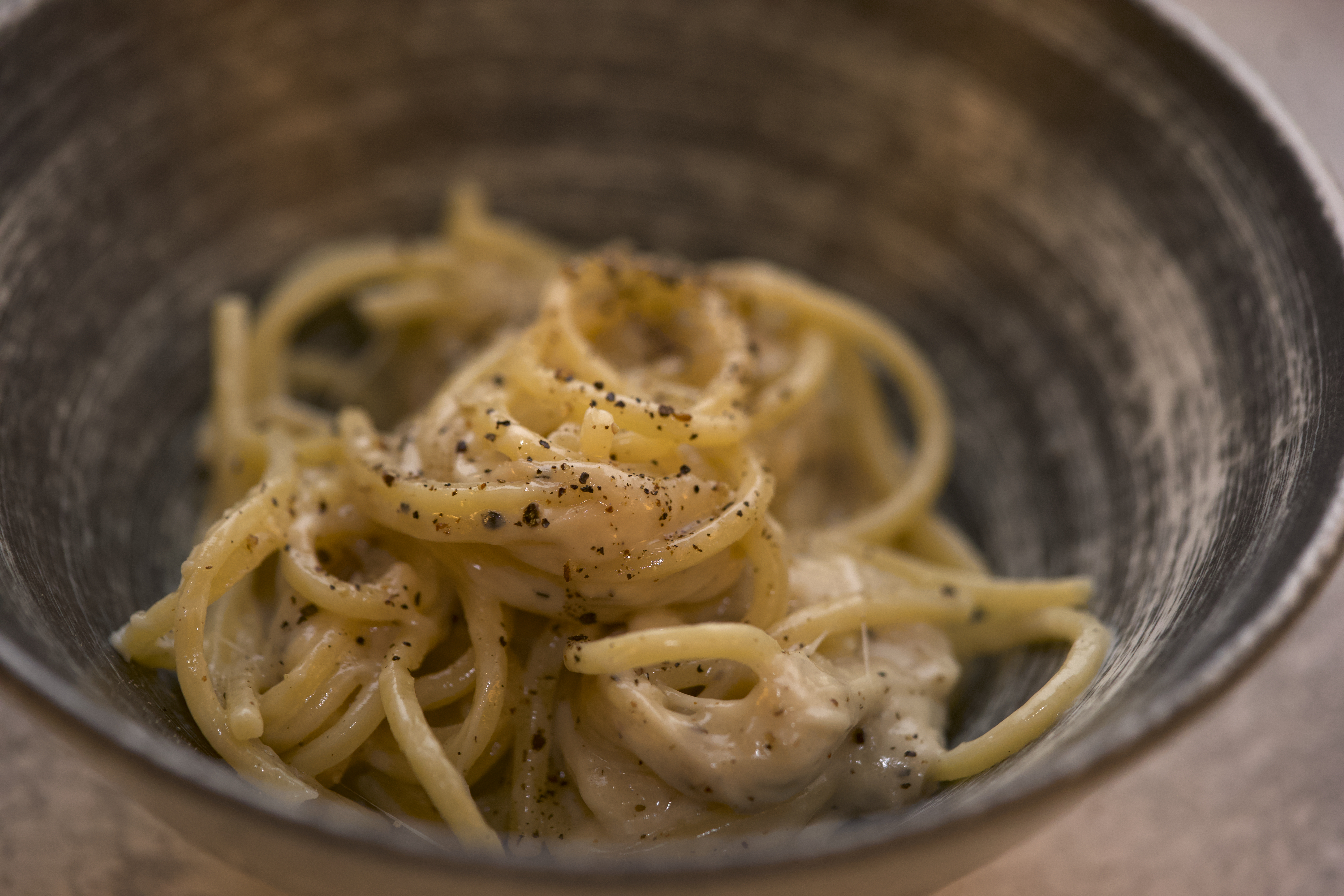
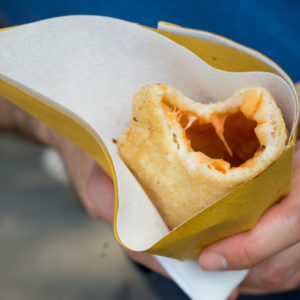
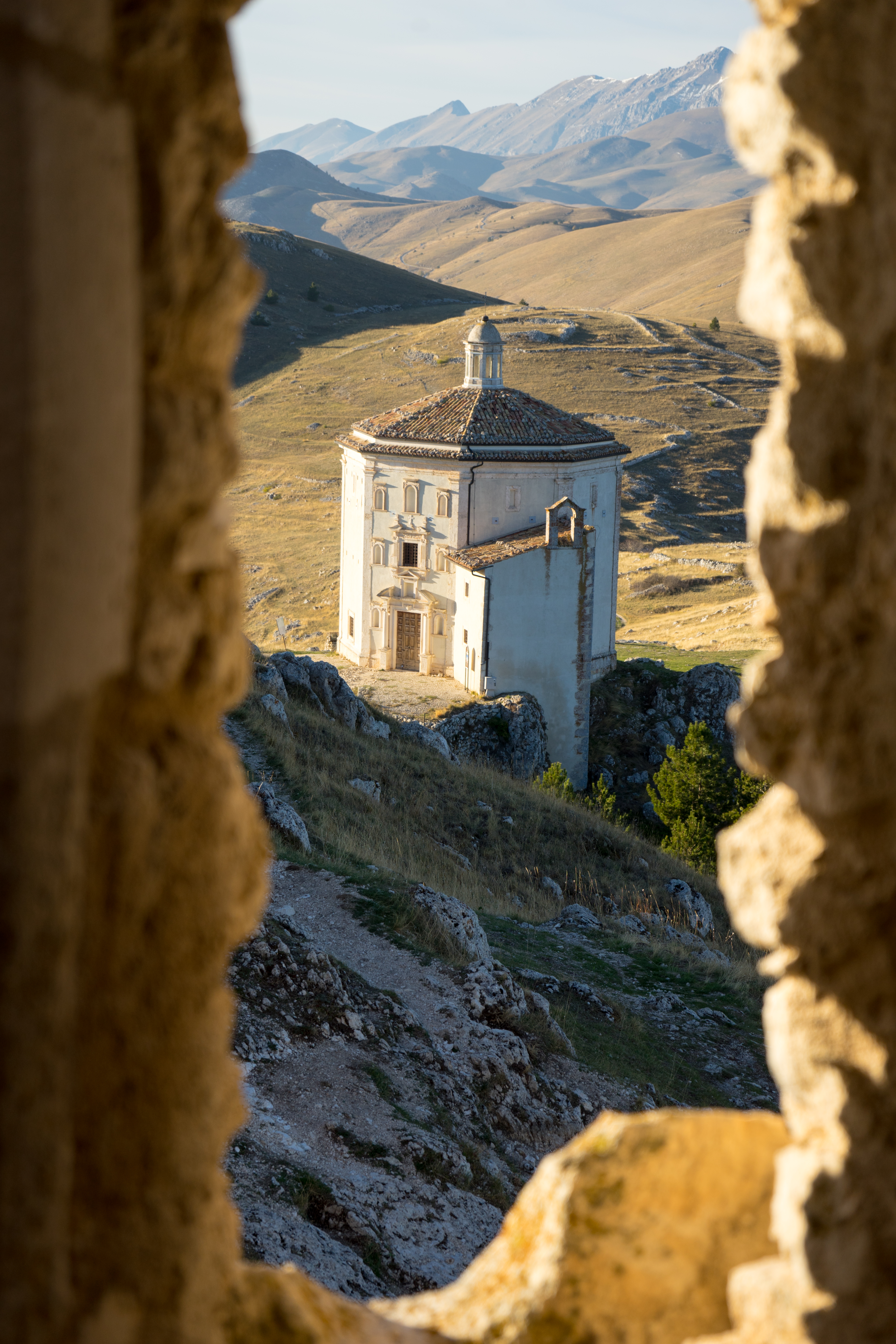
Leave a Reply